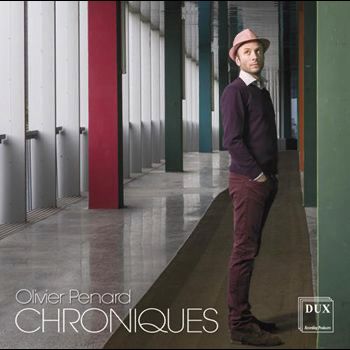|

Chroniques pour piano Op. 30
[32:54]
Piano, Dana Ciocarlie
Polyptyque dit «du diamant» (quatuor à cordes n°1) Op. 28 [17:24]
Quatuor Debussy
Artefact pour clarinette, violon, violoncelle et piano Op. 11 [20:35]
Quatuor Debussy
Clarinette, Jean-Marc Fessard
Piano, Jonas Vitaud
Charade pour violoncelle et accordéon Op. 29
[4:33]
Violoncelle, Fabrice Bihan
Accordéon, Philippe Bourlois
Enregistrement : 5-9 septembre 2014
à l'école de musique de Velizy-Villacoublay
Label Dux
DUX 1112
durée totale : [75:29]
|
Here is a case, for this listener anyway, of the accompanying «blurb» rather putting me off before I even started. I had not heard of Olivier Penard before this CD dropped onto my doormat so first of all read his biography. We are told that he is an autodidact who is positioned at the crossroads of contemporary creativity being influenced by « minimalist currents, jazz and film music ». Then we are told that he admires Ravel, Honegger, Dutilleux, John Adams and John Williams. All a bit of a « dog’s breakfast » you might mean- spiritedly think. Then I started to forget all that and just listened.
I was much taken with the work, which gives the CD its title, that is Chroniques for solo piano. It's a set of seven eclectic piano pieces each with an enchanting descriptive title. The spirit of Debussy surely looks over the composer’s shoulder. The first is Stupeur which is in a vague unmetred landscape of impressionistic harmony; the composer writes music without metre again later in the piece. The same feelings also apply to No. 3 Un regard (A look) which is beguiling in its loveliness and then to No. 5 where the music is « paralysed » by a debilitating love and No. 6 Un sourire (A smile). We end with No. 7 a Romance, almost a throw-back to French music of one hundred years ago. In contrast No. 2 Désordres is violent, highly dissonant and virtuoso with fisted note clusters. Éclats is also full of quite unexpected contrasts and moods.
These Chroniques are presented across the CD interspersed among up the other works. This is presumably in the mistaken idea that you might play the whole recording right through without a stop. I tracked the seven pieces to follow each other and if one does that then a sense of the overall shape of the work is more easily grasped. Dana Ciocarlie carries off every aspect of the music perfectly with superb pacing where necessary and wild intensity when needed.
The String Quartet, translated as The Diamond Polyptych, was inspired by an event which took place at the Cistercian abbey where it was composed, resulting in the burial of a diamond ring. It is in four highly original and often intense movements. The first is subtitled Luminous Weddings, an allusion to the couple who were buried with the ring. There is much musical information here and the music goes on to be more developed during the ensuing movements. The second is a short Shostakovich-like burlesque, the third, a slow and aching interlude with its slowly rising lines and the fourth subtitled Fruits of the Stars is full of wild and scurrying scales. It's a work to which I will return, I’m sure, and it is played here with marvellous conviction and understanding by the Quatuor Debussy.
Proof of Penard’s love of Dutilleux comes in the shape of the brief Charade for cello and accordion. It amounts to a series of inventions on a theme in the finale of the older master’s first Symphony a work that is quoted by Penard at the end. The accordion came to be used by Dutilleux in his later works and the cello concerto of Dutilleux is perhaps his finest work. Penard’s Charade is a witty and clever piece but no more than that.
I much enjoyed Artefact and it's interesting that it starts with a compositional plan, that is to open with an Overture in « a dry, dissonant sonic world » and to end with an exciting jazz-inspired Rhapsodie. In between there is a fascinating Scherzo-Rondeau, full of uneven rhythms and percussive chords, an Interlude which pays homage to the nocturnal world of Bartók who wrote his Contrasts for violin, clarinet and piano for that great cross-over clarinetist Benny Goodman. The finale is entitled Rhapsody-Jazz. Don’t expect pastiche Brubeck — it’s the syncopations and drive that make this an exciting jazzy movement. I really took to it as I did to almost all of Penard's music. I can also add that the performances are brilliant and full of energy. The documentation, written by Dominique Hayer, is quite detailed and often quotes the composer.
Gary Higginson, MusicWeb-International.com
Le catalogue du label DUX est extrêmement varié. Il permet d'entendre des œuvres du grand répertoire mais aussi des œuvres de compositeurs peu enregistrés, notamment français du XXème siècle comme Henri Busser, Jacques Ibert, Jean Français, Philippe Gaubert, Reynaldo Hahn, Henri Tomasi ou les grands maîtres de l'orgue tel que Charles Tournemire, Louis Vierne ou Charles Marie Widor. Deux compositeurs qui s'expriment aujourd'hui ont même droit à un CD qui leur est intégralement consacré : Renaud Gabriel Pion et Olivier Penard. Ce dernier, né en 1974, est autodidacte tout en ayant reçu les conseils de Philippe Capdenat et de Guy Reibel. Le présent enregistrement offre un panorama de sa production entre 2001 et 2012. Si les quatre œuvres enregistrées peuvent s'écouter séparément, une audition en continu se justifie tout à fait, car le CD est conçu comme une seule œuvre : les pièces à quatre ou deux instrumentistes sont encadrées par l'opus 30 – Chroniques – pour piano, à entendre comme des interludes. Leur interprète, Dana Ciocarlie, est remarquable : jeu franc, dense et varié. On remarquera l'atmosphère très debussyste du début de Stupeur qui débute l'œuvre et le romantisme discret de la dernière partie de ce cycle, Romance qui clôt l'enregistrement. Le quatuor à cordes opus 28 Polyptique dit « du diamant » est très subtilement introduit par les Debussy qui ensuite se jouent de la variété des rythmes comme cette valse en seconde partie de l'œuvre. Dans le quatrième mouvement, Fruit des étoiles, on peut entendre des accents proches de ceux qu'avait créés Janácek ; dans le cinquième et dernier, on évoquerait plutôt Stravinsky, soit autant de références subjectives qui peuvent être contredites par d'autres auditeurs. Ainsi dans sa présentation du CD, Dominique Hayer évoque pour le quatrième mouvement de cet opus 28 successivement Mahler et les minimalistes ! Artefact, composition la plus ancienne (2001), associe piano, violon, violoncelle et la clarinette virtuose de Jean-Marc Fessard. Avec lui et ses partenaires, la parenté, en particulier du dernier mouvement Rhapsody-Jazz avec les Contrastes de Béla Bartók est évidente.
Mais la composition la plus intéressante est sans doute Charade sur un thème d'Henri Dutilleux (en l'occurrence la première symphonie). Il n'y a pas de tendance au pastiche mais au contraire une réelle originalité, à commencer par l'alliage sonore entre un violoncelle et un accordéon, parfaitement réussi. Voilà bien une œuvre certes de dimension modeste mais vers laquelle on a plaisir à revenir. Cette charade échappe au reproche que l'on peut émettre à propos des autres œuvres ; que ce soit Chroniques, Polyptique ou Artefact, l'auditeur est trop sollicité à identifier les influences ce qui est un obstacle pour débusquer l'originalité des compositions d'Olivier Penard qui, cela étant, ont l'avantage de se laisser écouter. Tous les interprètes sont dignes d'éloge et la qualité de l'enregistrement excellente, mis à part une perspective sonore trop large pour Artefact. Le livret, en français, anglais et polonais, donne des œuvres un éclairage précis et dans un langage évitant le jargon. Disque intéressant consacré à un compositeur sans doute trop prisonnier de ses influences mais dont les œuvres restent séduisantes à l'écoute.
Gilles Ribardière, L'Education Musicale n°102 (septembre 2016)
retour
|


